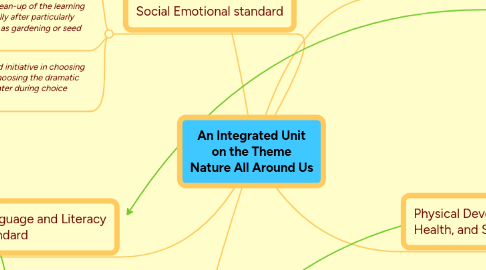An Integrated Unit on the Theme Nature All Around Us
by Melanie Reilly

1. Social Emotional standard
1.1. Favorite fruit chart: Students make their personal preferences known to others by completing a graph of favorite fruits as a class. Students demonstrate self awareness.
1.2. Clean Up: Students develop respect by participating in the clean-up of the learning environment, especially after particularly messy projects, such as gardening or seed collage.
1.3. Students demonstrate curiosity and initiative in choosing their own activities (for example, choosing the dramatic play center instead of the math center during choice time).
2. Mathematics standard
2.1. Seed Collage: Patterning--Students extend patterns offered by teacher (big-small, black-brown, etc.). Number Sense--Students count seeds used in project.
2.2. Sorting seeds: Students sort seeds by various attributes: color, size, shape, type, weight (using scales to compare), etc.
2.3. Read _Cucumber Soup_: Students develop Number Sense by counting insects on a given page or recognizing the numbers printed (ex: nine noisy mosquitoes).
2.4. Gardening: Students measure the length of flower and plant stems (using standard measurements, e.g. rulers, or nonstandard). Students compare growth of plants.
3. Science standard
3.1. Gardening: Students make predictions about what will happen to their seeds and test predictions using experimentation.
3.2. Nature walk: Students record and analyze data by creating a collection (of leaves, rocks, etc.), keeping a journal (drawings, letter-like symbols, or dictate to teacher) of what they observe.
3.3. Compare and contrast the attributes of collections from nature
4. Language and Literacy standard
4.1. Read _The Flower Garden_: Students should identify rhyming words (phonological awareness).
4.2. Read _What Living Things Need Water?_: Students should complete and KWL chart with teacher--what do students know, what do they want to learn, and, after reading, what have they learned about living things?
4.3. Create Vegetable Vests: Students will practice the /v/ sound (phonological awareness) by decorating paper vests with various vegetables.
4.4. Read _Annie Apple Farmer_: Students will draw a picture or "write" an event from the story. Students will discuss where our fruits and vegetables come from (farms, the orchard, etc.), and how these fruits may be used (pies, jams, etc.).
5. Creative Arts standard
5.1. Seed collage: Students use a variety of art materials to create a collage in a pattern/arrangement of their choosing.
5.2. Dramatic Play--The Apple Orchard: Students demonstrate understanding of behaviors that are important to particular roles, by playing the role of farmer, baker (of apple pies), etc.
5.3. Dramatic Play--The Fruit/Vegetable Stand. Students help create labels for produce (literacy standard--understanding the purpose of print/writing). Students take on role of cashier, other worker (stocking vegetables, bagging purchases, etc.), or customer.
5.4. Music and Movement: Students sing along and act out "The Ants go Marching" after observing ants during out nature walk and reading about ants in _Cucumber Soup_.
6. Physical Development, Health, and Safety standard
6.1. Fruit and Vegetable tasting: Students should try a variety, including unfamiliar foods, demonstrating healthy nutrition practices.
6.2. Nature collections: Students organize items from nature to develop fine motor skills. Use clothespins to pick up and sort leaves, twigs, etc., and twist the lids off of jars and other containers for storage.
6.3. Plant safety: Students discuss potentially dangerous plants. Should we touch a cactus? Why or why not?


